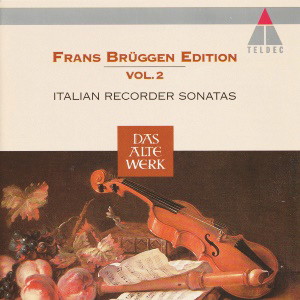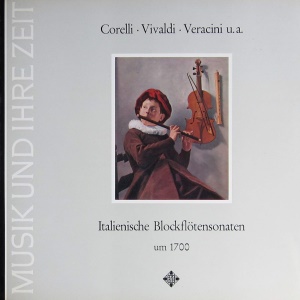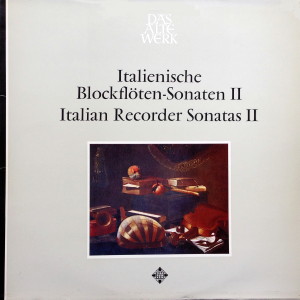 |
|
1 CD -
4509-93669-2 - (c) 1995
|

|
| 1 LP -
SAWT 9518-A - (p) 1968 |
 |
| 1 LP -
SAWT 9589-B - (p) 1973 |
|
| FRANS
BRÜGGEN EDITION - Volume 2 |
|
|
|
|
|
| ITALIAN RECORDER SONATAS |
|
|
|
|
|
| Arcangelo Corelli
(1653-1713) |
|
|
Variations on "La
Follia" op. 5, No. 12 in G minor
- from "Sonatas by Arcangelo
Corelli, his V opera",
London [Walsh] 1702
|
10' 09" |
|
| 1.
Adagio |
1'
14" |
|
| 2.
Allegro |
2'
15" |
|
| 3.
Adagio |
0'
39" |
|
| 4.
Vivace |
0'
21" |
|
| 5.
Allegro |
0'
12" |
|
| 6.
Andante |
0'
30" |
|
| 7.
Allegro |
0'
41" |
|
| 8. Adagio
|
1'
25" |
|
| 9. Allegro |
2'
49" |
|
|
|
|
| Francesco Barsanti
(1690-1772) |
|
|
Sonata
in C major - from "Sonatas
or solos for a flute with a
through bass for the harpsichord
or bass violin", London
1724
|
7' 43" |
|
| 10. Adagio |
1'
51" |
|
| 11. Allegro |
2'
49" |
|
| 12. Largo |
1'
29" |
|
| 13. Presto |
1'
34" |
|
|
|
|
| Francesco Maria
Veracini (1690-1768) |
|
|
Sonata
in G major - from "Sonate
a Violino, o Flauto solo e Basso",
Venice 1716
|
9' 05" |
|
| 14. Largo |
2'
22" |
|
| 15. Allegro |
2'
17" |
|
| 16. Largo |
1'
45" |
|
| 17. Allegro
|
2'
41" |
|
|
|
|
| Diogenio Bigaglia
(c.1676 - c.1745) |
|
|
Sonata
in A minor - from "Sonata
a fluta di quatre e basso"
|
7' 15" |
|
| 18. Adagio |
1'
40" |
|
| 19. Allegro |
2'
05" |
|
20. Tempo di
Minuetto
|
1'
28" |
|
| 21. Allegro |
2'
02" |
|
|
|
|
| Nicolas Chédeville
(1705-1782) |
|
|
Sonata
op. 13, No. 6 in G minor -
from "Il pastor fido.
Sonates pour La musette, viele,
flûte, hautbois, violon, avec la
basse continüe... opuera XIII",
Paris [Boivin] 1737
|
4' 56" |
|
| 22. Vivace |
1'
24" |
|
| 23. Alla breve |
1'
54" |
|
| 24. Largo |
1'
21" |
|
| 25. Allegro ma non
presto |
3'
17" |
|
|
|
|
| Benedetto Marcello
(1686-1739) |
|
|
Sonata
op. 2, No. 11 in D minor - from "XII
Suonate a Flauto solo con suo
Basso", Amsterdam
before 1717
|
8' 16" |
|
| 26. Adagio |
2'
22" |
|
| 27. Allegro |
2'
07" |
|
| 28. Largo |
1'
19" |
|
| 29. Allegro |
2'
28" |
|
|
|
|
Arcangelo Corelli
(1653-1713)
|
|
|
Sonata
op. 5, No. 4 in F major - from
"12 Sonate a Violino e Violone o
Cimbalo", Roma 1700
|
11' 36" |
|
| 30. Adagio |
2'
28" |
|
| 31. Allegro |
2'
28" |
|
| 32. Vivace |
1'
27" |
|
| 33. Adagio |
2'
31" |
|
| 34. Allegro |
2'
42" |
|
|
|
|
Francesco Maria
Veracini (1690-1768)
|
|
|
Sonata
in A minor - from "Sonate
a Violino, o Flauto solo e Basso",
Venice 1716
|
9' 44" |
|
| 35. Largo |
1'
30" |
|
| 36. Allegro |
2'
13" |
|
| 37. Allegro |
3'
01" |
|
| 38. Allegro |
3'
00" |
|
|
|
|
| Frans Brüggen, recorder |
|
| Anner Bylsma, violoncello |
|
| Gustav Leonhard,
harpsichord |
|
|
|
|
|
Luogo
e data di registrazione |
|
-
Bennebroek (Olanda) - febbraio
1967 [1-25]
- Amsterdam (Olanda) - giugno 1972
[26-38]
|
|
|
Registrazione:
live / studio |
|
studio |
|
|
Producer /
Engineer |
|
Wolf
Ericson [1-25] - Heinrich Weritz
[26-38]
|
|
|
Prima Edizione
LP |
|
-
Telefunken "Das Alte Werk" - SAWT
9518-A - (1 LP) - durata 41' 06" -
(p) 1968 - Analogico [1-25]
- Telefunken "Das Alte Werk" -
SAWT 9589-B - (1 LP) - durata 40'
54" - (p) 1973 - Analogico [26-38]
|
|
|
Edizione CD |
|
Teldec
- 4509-93669-2 - (1 CD) - durata
72' 43" - (c) 1995 - ADD |
|
|
Note |
|
- |
|
|
|
|
In
early eighteenth-century Italy
the violin gradually
displaced the recorder as a
solo instrument, bringing to
an end a tradition dating
back many hundreds of
year's. A number of the
composers who had written
music chiefly for the
recorder drew the inevitable
consequence from this
development and went to live
abroad. with England proving
the most popular
destination. One such
composer was Francesco
Barsanti who in 1724
published an anthology under
the title Sonatas or
solos for a flute with a
thorough bass.
The C major Sonata for
recorder in f' is
taken from this collection.
Technically speaking, it is
a highly demanding piece and
attests to Barsanti’s
thoroughgoing knowledge of
the instrument.
In
England composers could
still hope to find an
enthusiastic audience for
recorder music. Indeed,
the end of the seventeenth
century proved something of
an Indian
summer for the instrument,
with household music
especially being able to
draw upon a wide repertory
ranging from transcriptions
of popular songs and
operatic arias to whole
operas. As
a result, the recorder was
often referred to on the
European mainland as the flûte
d'Angleterre.
In
France and Germany, too, the
recorder continued to have
an important role to play,
albeit in a form adapted to
suit the new multicoloured
tonal ideal of orchestras
around 1700. The age to
which it had contributed
"quiet, charming harmonies" (to
quote Michael Praetorius)
was past. Of the once large
recorder family all that
remained to contest the
field were the descant and
treble recorders (known in
the USA as the soprano and
alto respectively), since
they alone were capable of
taking the top line in the
Baroque orchestra and of
meeting the manifold needs
of solo writing in chamber
music.
A late
seventeenth»century
invention is the socalled
quart flute, which sounds a
fourth higher than the
treble instrument. One of
the few pieces written for
the quart flute is the
Sonata in A minor by
Diogenio Bigaglia,
prior at the Benedictine
monastery' of San Giorgio
Maggiore in Venice.
In Italy,
recorder pieces were almost
always published in
alternative versions for Flauto
o Violino or were
violin works transcribed for
recorder, but it was as
recorder pieces that they
tended to find a place for
themselves in the repertory.
In their version for
recorder, Arcangelo Corelli`s
Variations
on La Follia from
his op. 5 set of sonatas are
one of the composers most
famous pieces. These
Variations
were first published in Rome
in 1700
but by 1702 a
version for recorder had
already been published by
Walsh of london and by 1720
had been reprinted no fewer
than twenty times.
The work differs only in
points of detail from the
version for violin and
demands a high degree of
technical competence on the
part of its performer, since
Corelli, an accomplished
violinist, conceived the
work as a virtuoso bravura
showpiece. The folia or
ostinato bass, after which
the piece is named, is a
solemn, weighty theme that
is subjected to a total of
twenty-one
variations to produce a
veritable firework display
of ideas. The F major
Sonata comes from the satire
collection. All
the op. 5 pieces are of
importance for the way in
which Corelli has added a
fifth movement to the four-movement
model of the sonata da
chiesa, a
model that he himself had
helped to establish.
Francesco Maria
Veracini
was another accomplished
violinist and one of the
best-known virtuosos of his
day. A meeting
between him and the equally
famous violinist Giuseppe
Tartini is said to have left
Tartini so impressed by
Veracini’s bowing technique
that he withdrew from public
life for a time to improve
his own technique and match
his rival’s skills.
Veracini’s
forte as a composer lay in
the genre of the sonata
da camera as
represented by the sonatas
included in the present
recording. Both are taken
from a collection published
under the title Sonate a
Violino o Flauto solo e
Basso and dating from
the composers earliest
period. Already
famous as a virtuoso, the
young Veracini dedicated
this collection to the
Prince Elector Friedrich
August of Saxony in 1716.
The A minor Sonata reveals
him in a particularly
innovative vein, the
sequence of movements (Largo
-
Allegro - Allegro
- Allegro) flying in the
lace of all conventional
expectations, while the hint
of a second theme in the
final movement already looks
forward to Classical sonata
form.
For a long time there were
doubts about the
authenticity of the
collection of sonatas
published in Paris under the
title Il pastor fido.
Although these sonatas
appeared under Vivaldi`s
name in 1737 - in other
words, towards the end of
the composer's lifetime -
there were suggestions that
the attribution might have
been designed as a marketing
ploy by the publisher. Not
until 1990
did suspicions become a
certainty when a sworn
statement was discovered
confirming that the G minor
Sonata was in fact the work
of the contemporary musette
player, Nicolas Chédeville.
Only the exceptionally
virtuosic final movement has
been taken over, in a
slightly shorter version,
from the opening movement of
Vivaldi's Violin Concerto in
G minor RV 316.
Ulrike
Brenning
·····
A brief
history of the
recorder
2.
The recorder from in
the 17th
century
An
important development in
the history of the
recorder and its
repertory took place in
England in the 16th
century. It was here
that six members of the
Bassano family from
Venice settled around 1530,
quickly establishing
themselves as recorder
players and makers.
One of their number,
Jacomo, later returned
to Venice and,
together with those of
his brothers who had
remained in England,
formed a confraternity
to produce and sell
wind instruments.
Evidence
of the widespread
popularity of
Englich recorders
comes in the form of
two references in
contemporary texts
from Augsburg
("large chest
containing 27
recorders, large and
small, of a type
made in England")
and Paris ("these
crumhorns are made
in England", from
Mersenne's treatise
of 1636). In 1603,
five members of a
later generation of
the Bassano family
played the recorder
at the funeral of
Elizabeth I. Also
from this period
dates Anthony
Holborne's Pavans,
Galliards, Almains
[...] for Viols,
Violins, or Other
Musicall Winde
Instruments, a
collection of
five-part dances for
broken consort,
i.e., an ensemble
comprising different
kinds of
instruments,
generally gambas and
recorders. In this
case, one assumes
that larger
instruments such as
tenor, basset, bass
and great bass were
used.
Michael
Praetoriu's
encyclopædic study
of the theory and
practice of music, Syntagma
musicum
(1614-20),
includes, in
its second
part, a list
of eight
different
sizes of
recorder - Klein
Flöttlin
(g"), Discant
(d"), Discant
(c"),
Alt (g'),
Tenor (c'),
Basset (f),
Bass (B flat)
and Grossbass
(F). The
larger
instruments,
he suggest,
could be used
together in a
consort. (He
also mentions
that voices
and
instruments
could be
combined in a
consort.)
Praetorius was
the first to
state that
recorders
normally sounf
an octave
higher than they are notated
and that the length of the
tube could be altered in
order for the instrument to
be tuned. (It
was not yet usual at this
time to construct the tube
in two sections.) He also
mentions that it was
possible to buy a great
consort, comprising 21
recorders from Klein Flöttin
to Grossbass,
for 80 thalers in Venice.
In
his Harmonie universelle
of 1636/7, Marin Mersenne
divides recorders into two
sets, a petit jeu
comprising dessus
in g', haute-contre
& taille in c',
and basse in f,
and a grand
jeu made
up of dessus
in f, haute-contre
& taille and basse,
in other words,
five different sizes.
Mersenne describes the
recorder variously as the "fluste
d‘Angleterre" (English
flute), the "fluste
douce" (a reference to its
“sweet” tone) and the "fluste
à
neuf trous" (a reference to
the instrument's eight
finger-holes and one thumb-hole),
adding "The
[...] large flutes were sent
to one of our kings from
England". As an example of
music for a recorder consort
he quotes a four-part Gavote
pour les Flustes douces
by Henry le Jeune,
ie., Jehan
Henry the Younger.
In 1646 Paulus Matthysz of
Amsterdam published Der
Fluyten
Lust-hof, a
collection of "psalm, pavans
and allemandes", as
well
as well-known songs of the
period, compiled and
ornamented by Jacob
van Eyck of Utrecht. In
his foreword, Matthysz
describes the hand-fluit,
a recorder in c"
similar to our modern
descant (American: soprano)
recorder. This instrument
was still made of a single
piece of wood and had a
range of two octaves and a
note. This is the sort of
instrument that was
frequently reproduced in
17th-century Dutch paintings
and engravings, generally as
part of genre scenes
depicting domestic
interiors, taverns or street
life.
Peter
Holtslag
Translation:
Stewart Spencer
|
|